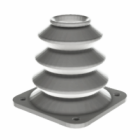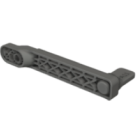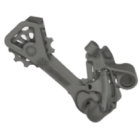3D printing benefits
3D printing is no longer a novelty — it’s a core manufacturing method used across industries ranging from aerospace and automotive to healthcare and education. But what is the real value of this technology, and why are so many companies investing in it?
In this chapter, we explore the key benefits of 3D printing. Whether you’re a designer, engineer, or production manager, understanding these advantages will help you identify where additive manufacturing fits into your workflow — and how it can offer real, measurable impact.
Design freedom: one of the top reasons for 3D printing
One of the most cited reasons for 3D printing is its ability to unlock geometry that traditional manufacturing simply can’t handle. Complex internal channels, organic shapes, undercuts, and custom contours can be produced without the need for molds or multi-part assemblies.
Designers are no longer constrained by traditional tooling. That means fewer compromises between form and function — and far greater innovation.
Explore how this design flexibility plays out in practice in our section on design guidelines.
Rapid prototyping as a key 3D printing technology benefit
Speed is another major benefit. With 3D printing, you can go from idea to physical object in a matter of hours — not weeks.
This radically shortens development cycles, allowing engineers and product teams to test, iterate, and refine their designs without costly delays. This is one of the most practical 3D printing technology benefits: it accelerates decision-making and reduces time-to-market.
- Prototype overnight, test the next morning.
- Reduce outsourcing and lead times.
- Enable real-time design validation.
SLS, in particular, enables production-ready prototypes with mechanical properties close to final parts. Learn more about its capabilities in the Selective Laser Sintering chapter.
No tooling required: why 3D printing simplifies production
Traditional manufacturing requires expensive molds, dies, or custom tooling — all of which take time and money to produce. With 3D printing, you can eliminate tooling altogether for short runs, one-offs, or highly customized parts.
This is especially powerful in industries like medical, where personalized products are standard, or in low-volume production, where tooling costs are hard to justify.
- Print jigs and fixtures on demand.
- Manufacture low-volume parts economically.
- Enable full customization without cost penalty.
Cost efficiency: what is the advantage of 3D printing in product development
It’s important to be honest: 3D printing isn’t always cheaper than injection molding or CNC machining. But when you account for the full product development lifecycle — including design changes, tooling revisions, and wasted inventory — additive manufacturing can significantly reduce total cost of ownership.
Key savings areas:
- no need for molds or tooling,
- reduced material waste (especially with SLS),
- shorter iteration cycles,
- less inventory — print what you need, when you need it.
Cost efficiency depends heavily on application. Use our Cost Comparison Guide to evaluate where 3D printing makes the most financial sense.
Digital inventory: a major benefit of 3D printing on demand
With 3D printing, parts don’t need to exist physically until they’re needed. Instead of stocking shelves with spares, you can store digital files and produce parts on demand.
This shift toward digital warehousing dramatically reduces storage costs, minimizes obsolete stock, and makes decentralized production more viable than ever before.
- Ideal for spare parts and aftermarket support.
- Enables localized production closer to the point of use.
- Supports just-in-time manufacturing models.
Performance optimization through lightweight 3D printed parts
What is the advantage of 3D printing over traditional processes in structural applications? Lightweighting.
Using internal lattices or topology optimization, engineers can reduce material usage while maintaining — or even improving — part strength. This is especially relevant in industries where every gram matters, like aerospace and automotive.
- Optimize parts for weight-to-strength ratio.
- Reduce energy consumption and fuel usage.
- Lower shipping costs for distributed production.
Sustainability: how 3D printing reduces waste and material use
Traditional subtractive manufacturing removes material from a block — often resulting in significant waste. In contrast, additive manufacturing builds parts layer by layer, using only the material necessary.
Summary of 3D printing benefits
To summarize, the core 3D printing benefits include:
- greater design freedom,
- faster product development cycles,
- no tooling required,
- lower total costs for complex or low-volume parts, on-demand and digital inventory solutions,
- lightweighting and performance optimization,
- improved sustainability through material efficiency.
These aren’t just theoretical gains — they translate directly into faster innovation, leaner operations, and better products. Additive manufacturing is not a replacement for every traditional process, but in the right context, it offers distinct and often transformative advantages.
Explore also
- What is print 3D? Concept of 3D printing
- What does “3D printed” mean?
- Example of 3D printing
- How does 3D printing work?
- Slicing in 3D printing
- What do you need for 3D printing?
- Is 3D printer dangerous? Understanding the real risks
- 3D printing issues
- 3D printing history
- 3D printing facts
- Who uses 3D printers? Not just for engineers anymore
- Where 3D printing is used
- 7 common 3D printing myths
- 3D printing global market
- Cultural impact of 3D printing
- Hybrid manufacturing (CNC + AM)
Related categories



